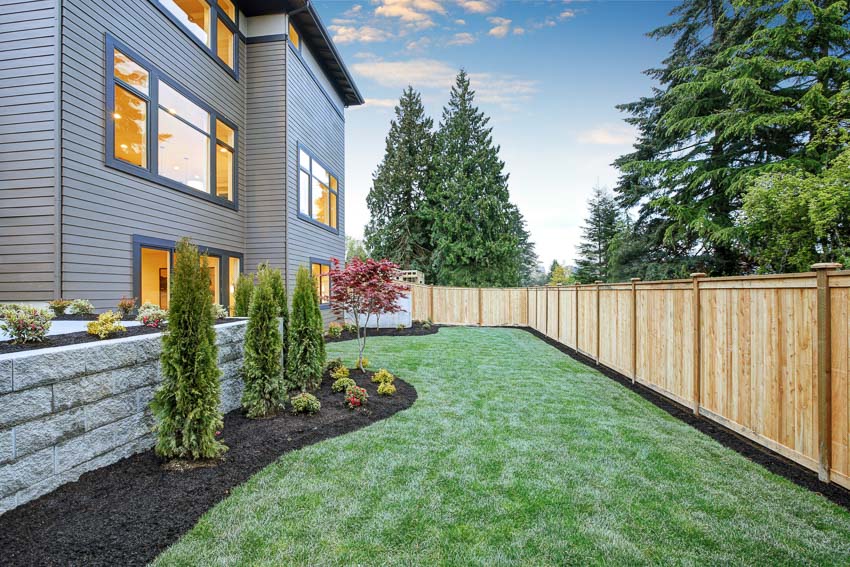Wood fences attract many homeowners thanks to their timeless charm and affordability. They are the most versatile type of fencing material, outpacing every other type of fence in terms of privacy and design options. Before you commit to installing one, find out everything you need to know about wood fence styles, costs, and benefits.
What Are Wood Fences? A Natural and Timeless Option
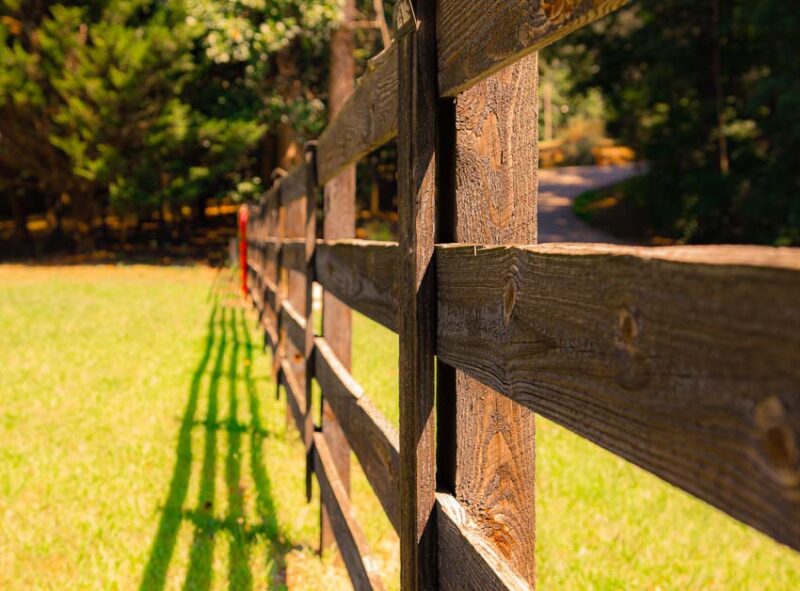
Wood fences come in various styles and sizes and are both durable and attractive. You can combine wood with many other types of fencing materials to create unique and ornate designs. Moreover, it’s one of the easiest fences to customize for various purposes.
History and Appeal
Archaeologists believe that humans started using fences over 14,000 years ago. The word “fence” comes from the Middle English word “fens” which means to protect or defend.
The invention of the fence, though not clearly known, is one of the defining moments leading to the advancement of civilization.
Like modern-day fences, the first fences were probably used for various purposes. As the Swiss philosopher Jean-Jacques Rousseau stated in the 1700s, “The first man who, having enclosed a piece of ground, bethought himself of saying “This is mine,” and found people simple enough to believe him, was the real founder of civil society.”
They are an excellent way to create a boundary, increase your backyard’s privacy, and improve your property’s aesthetics. As one of the oldest and most popular fencing materials, they provide numerous benefits to present-day homeowners.
Key Components and Materials: Different Types of Wood
Deciding to use wood for fencing still leaves you with many choices, as there are several types of wood and styles of fence to choose from. The type of wood you choose affects the cost and other factors like durability, appearance, privacy, and noise buffering.
Here are the most common types of wood used to build fences, all of which can be customized with paint or stain:
| Type of wood for fencing | Advantages | Average cost per linear foot |
| Cedar | Resistant to rot, insects, moisture, and sun exposure | $5 to $15 |
| Cypress | Extremely durable and rot resistant | $10 to $15 |
| Pressure treated pine | Long-lasting, usually costs less than other types of wood | $5 to $15 |
| White oak | Can resist decay for several decades | $15 to $40 |
| Redwood | Has an attractive deep red color and is resistant to rot, insects, and sun exposure | $15 to $30 |
| Spruce | Inexpensive, with an attractive soft gray color | $3 to $10 |
| Composite wood | Made from recycled and sustainable materials, durable and resistant to warping | $15 to $35 |
Popular Wood Fence Styles and Designs
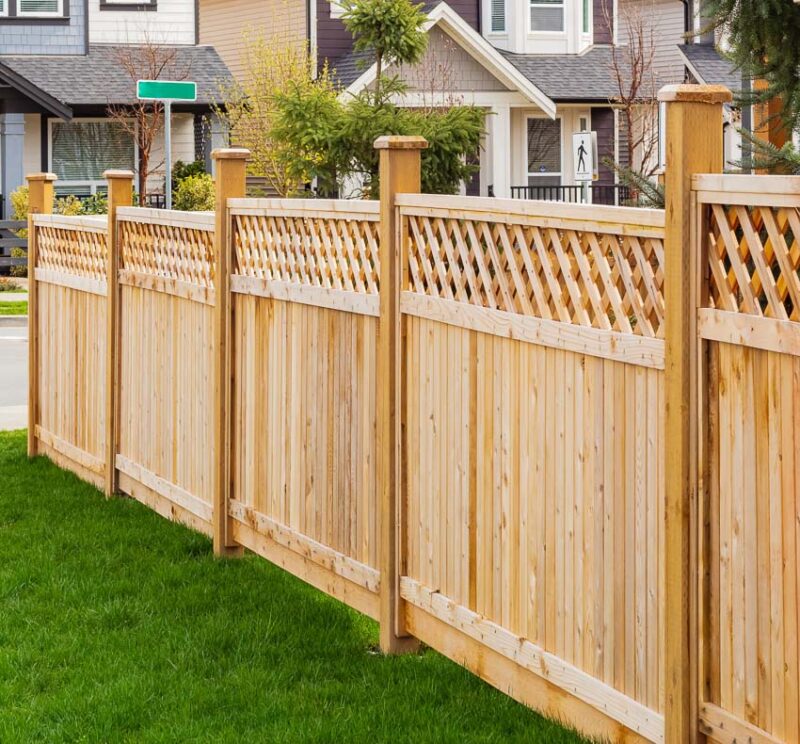
Because wood fencing is so versatile, you can also choose from a wide range of fence styles in addition to being able to choose the type of wood. This flexibility allows people to create unique and attractive fences that enhance the visual appeal of their homes and property.
Many of these styles are also available as prefabricated wood fence panels. These panels make installation easy and can lower the costs of your project, especially if you hire someone to install your fence.
Here are the most common styles:
| Style of wood fencing | Best for | Average cost per linear foot |
| Split-rail fence | Creating a boundary, containing livestock, and adding a rustic look | $10 to $28 |
| Picket fence | Enhancing your home’s curb appeal and increasing the value of your property | $10 to $75 |
| Lattice fence | Adding privacy without blocking airflow and trellising vines and garden vegetables | $7 to $21 |
| Board-on-board | Creating privacy and blocking wind | $15 to $21 |
| Shadow box fence | Providing privacy without reducing light | $17 and $35 |
| Louvered fence | Adding privacy without blocking sunlight and breezes | $35 |
| Stockade fence | DIY installations that are easy on your budget | $15 and $20 |
Cost of Wood Fencing: Factors and Pricing
The type of wood and the style of the fence are the major factors that influence the cost of wood fencing, but other factors like production costs, installation costs, and decorative add-ons can also affect wood fencing costs.
To find opportunities to save money and build your wood fence for less, learn more about the factors that affect the cost of wood fencing.
Material and Production Costs
For materials alone, the cost is generally about $6 to $18 per linear foot, making them one of the most affordable DIY fencing options. Here are some factors that affect the cost of wood fencing materials:
Material and Production Costs
These types of fences cost $6 to $18 per linear foot, making them one of the most affordable DIY fencing options. Here are some factors that affect the cost of wood fencing materials:
- The size of your fence, including length and height
- The style of the fence
- The quality, grade, and type of wood
- Lumber price trends
- The materials needed for your gate
- The cost of the stain or paint
Installation Costs and Labor Considerations
Installation costs vary, but people spend about $14 to $35 per linear foot on labor to install a wood fence. Several factors can affect the labor costs of your fencing project, including the following:
- Hiring a professional versus DIY installation
- The type of wood, as some woods are easier to work with than others
- Type of fence
- Using panels
- Design complexity
- Number of posts
- The length and height of your fence
- Regional labor costs
- Terrain and soil conditions
- Landscaping obstacles that require tree removal or leveling
- Other special requirements, skills, or tools
Customization and Decorative Elements
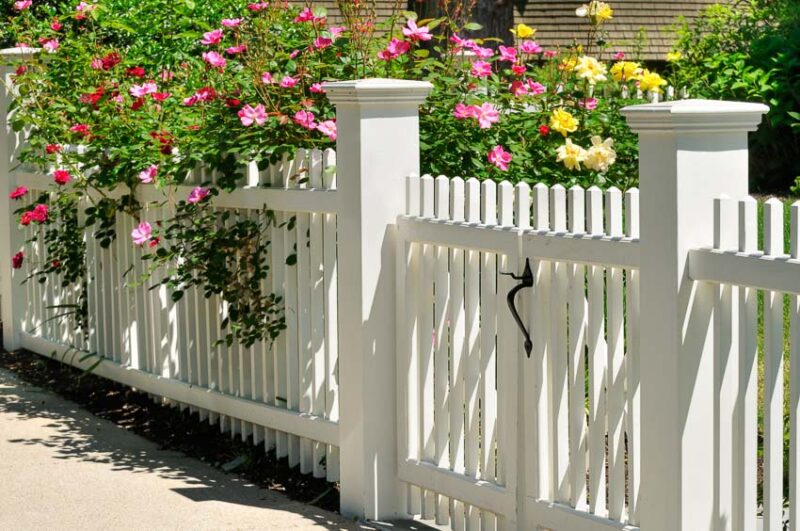
Their versatility makes them easy to combine with numerous types of decorative elements. Here are some common customizations and add-ons that you can use that will affect the final cost of your wood fencing project:
- Planter boxes
- Pergola fence toppers
- Lattice screening panels
- Metal screens and panels
- Custom stains and designs
- Decorative post caps and finials
- Arched or scalloped designs
- Ornate designs
- Intricate designs, like diagonals or herringbone patterns
Maintenance and Repair Expenses
Wood shines in almost every category, but when it comes to maintenance and repair, it has a distinct disadvantage. However, although wood requires a lot of maintenance and repairs, it’s generally easy and DIY-friendly.
Maintenance
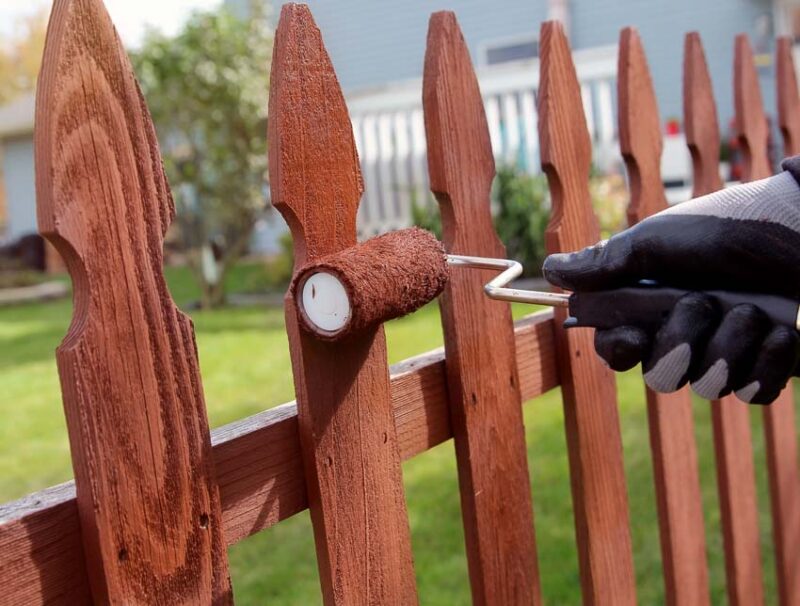
Wood fences need to be cleaned and repainted or stained every few years. Here are the most common types of maintenance that you may be faced with if you choose wood fencing:
- Staining or painting
- Checking for rot, water damage, and insect damage
- Clearing debris and vegetation
- Removing moss
- Removing peeling paint
Repairs
The average homeowner pays $10 to $25 per linear foot to repair wood fences. The larger the area to be repaired, the more it will cost. Common fence repairs include replacing broken boards or posts and repairing boards and gates. Most repairs cost between $300 and $800, including labor and materials.
Why Choose Wood Fencing Over Other Fencing Options?
There are many reasons to choose wood fencing over other fencing options. No other fence type comes close to offering the versatility of wood, and it’s practically unmatched in aesthetic value. Wood is also an eco-friendly choice because it is made from sustainable materials and can be recycled.
Aesthetic Appeal and Versatility
Wooden fences can enhance the visual appeal of any landscape, and because you can choose from various styles and finishes, it’s easy to match your fence to your home’s exterior and the design elements in your yard.
Here are some of the ways that wood materials contribute to the aesthetic value, versatility, and style of your fence:
- Able to be painted or stained to match any color
- Can be designed and built to enhance the architectural design of your house
- Can be designed and built to match the curves or lines in your yard
- Available in a variety of styles, from modern to rustic
- Can be combined with many other fence materials to create strong, durable, and unique fences
Environmentally Friendly Choice
Wood is an eco-friendly option because lumber is a sustainable product. It’s also 100% recyclable and biodegradable. When choosing environmentally friendly building materials, it’s important to consider where they come from and end-of-life disposal.
Materials rarely end up in landfills because wood is one of the most biodegradable materials available.
Consider using salvaged wood when you’re looking for an environmentally friendly material to build a fence. You can make a fence from reclaimed lumber by visiting local salvage shops to see what’s available.
Privacy and Noise Reduction
Very few fence materials can rival a wooden fence regarding privacy and noise reduction. And their flexibility allows you to build them tall enough to make your yard completely private or shorter so you can still enjoy a view.
Solid fence materials are best for reducing noise pollution, and wood is one of the best materials for absorbing sound. To maximize the ability of wood to block noise, choose a heavy, durable type of wood with a thick dimension, limit the gaps in the fence, and make it as tall as possible.
Customizable and Easy to Repair
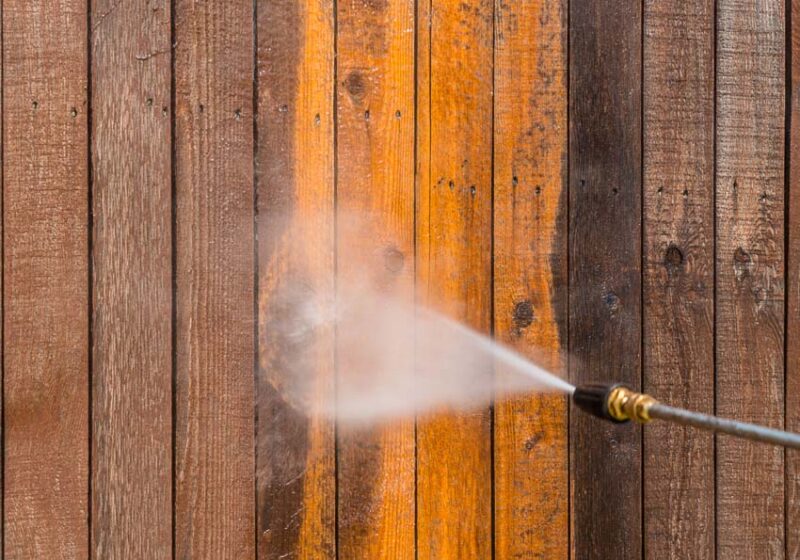
Wood is one of the most DIY-friendly fence materials you can choose from, and it’s easy to repair and maintain. Maintenance and repairs usually include reattaching boards, replacing posts, and staining your wood fence.
Even if you hire a professional to tackle your repairs, you’ll pay less than you would with other types of fences.
It’s possible to create a wood fence that meets your needs. You can build a fence that solves problems like privacy and security issues while enhancing your home’s visual appeal.
Choosing ornate designs or decorative elements like lattice panels and pergola tops can give your home and yard a creative flair and make it stand out from the rest of the homes in your neighborhood.
Wood Fencing FAQs

How much do wood fences typically cost?
The national average cost is between $2,500 and $4,500. However, the cost can vary considerably depending on the type of wood you choose and the type of fence you install. Depending on your reason for fencing, you can save money by choosing a less expensive style of fence, but you must also consider other factors like labor costs and add-on features.
What are the main differences between wood and other fencing materials?
Wood is the most versatile fencing material and can be used to create attractive, private, and secure fences. Wood is much more attractive than chain link fences, and wood is less expensive than wrought iron fences.
Vinyl offers many of the same benefits as wood but is not as customizable. Wood is an inexpensive fencing option that’s easy to install, but on the downside, wood requires more maintenance than other fence materials.
How do I protect my fence from rot and damage?
You can protect your wood fence from rot and damage by treating it with stain or paint. Regular cleaning, keeping fence boards off the ground, setting your posts in concrete, and adding top caps are other ways to protect your fence.
Can you customize them to match my property’s style?
One of the most significant advantages is their customization ability, making it easy to match a wood fence to the rest of your property. Choose design elements from your yard and house exterior, and repeat them to create a unique fence that provides a cohesive visual appeal for your entire property.
What is their average lifespan?
Wood fences have an average lifespan of 15 to 20 years, but there are several ways to increase the longevity of a wood fence. Start with a durable type of wood and a strong style of fence. Then, as soon as it’s installed, treat your wood with paint and stain, and be sure to clean it regularly. You should restain or repaint it every few years to keep it looking its best and ensure it lasts a long time.

